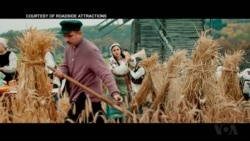“I wanted something that looked like a fairy tale,” says German-born Canadian filmmaker George Mendeluk, describing what compelled him to tackle one of the darkest chapters in Ukrainian-Russian relations.
Opening with a picturesque scene of a Ukrainian village in the 1930s, the historical juxtaposition is stark: Bitter Harvest, a historical drama that weaves a love story around cataclysmic events surrounding the Holodomor — the devastating state-sponsored famine in Ukraine that killed millions — can’t help but draw comparisons with today’s news coverage of nearby regions.
Released worldwide Friday, Mendeluk’s first full-length film sheds light on a tragedy that, concealed by Soviet authorities for decades, remains little-known outside of Ukraine today.
Watch: Past, Present Collide on Set of 'Bitter Harvest'
Anchored by the fairy-tale romance of rural teens Yuriy and Natalka, played by Britain’s Max Irons and Samantha Barks, the script rapidly interweaves cruelties of a Soviet regime steamrolling the Ukrainian peasantry, leaving millions dead in its wake.
Striving for historical accuracy
Toronto-based producer and financier Ian Ihnatowycz says the film, shot on location in parts of Kyiv and in London on a budget of $20 million, aims for unflinching attention to historical detail.
“When [Canadian actor] Richard Bachynsky brought this script in 2011, I immediately was interested because of my background and knowledge of the Holodomor,” Ihnatowycz told VOA’s Ukraine Service. “I felt it was important to present a film with international stars in a style that would appeal to Western audiences.
“We focused a lot of effort on making sure that the film was historically accurate,” he added. “It was verified by many historians.”
The weight of coming to terms with finer details of the Holodomor wasn’t lost on the cast.
“We were quite embarrassed that we didn’t really know too much about it,” said British actor Tamer Hassan, who plays Sergei, a Soviet commissar who terrorizes Ukrainian peasants. “You know, people say ‘Stalin, Stalin! Horrible!’ We all know something was there, that there was some kind of a tragedy, but to the extent of how bad it was, we really didn’t know.”
Current events echo the past
“When you read the script, you understand that there is a reason you don’t know about it,” Barks said. “There is a reason that so many people don’t know about it.”
In a seemingly ominous turn of events, anti-government protests broke out as filmmakers were finishing portions of the film shot on location in Kyiv.
“When we were filming in Ukraine, we were obviously going through this really sad part of history, and then a couple of weeks later revolution started,” Barks said.
Historical events that gave rise to the film, its creators say, seemed to collide with current affairs, in a way that they hope can help Western audiences better understand the deeper context of tensions left in the wake of a Russian invasion.
Although the film’s first reviews are not all positive, director Mendeluk says such an epic undertaking would challenge even the most seasoned cinematographers.
“There is such a huge, huge canvas,” he told VOA. “We had a love story. We had Holodomor. We began with Bolshevik Revolution. We had so many things that we needed to explain, and we had to edit it down.”
This report was produced in collaboration with VOA’s Ukrainian Service.











